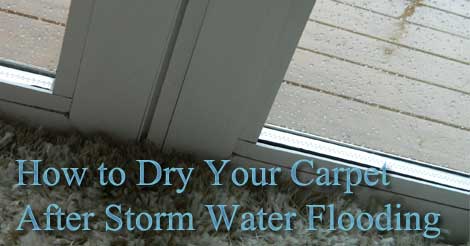Storm Water Flood
Dealing with a storm water flood in your carpet is no picnic. A flood can range from a small inconvenience to a hazardous situation. If you find yourself with damp carpet or an inch of standing water, remember two words: extraction and drying! Depending on the amount of flood water in your carpet, you’ll likely need to consult with a professional for advice and/or service. There are a few things you can do immediately to remedy the flood situation in your home.
NOTE: This advice is intended for homeowners who have experienced a small amount of storm water invading their home or carpet. Each situation is different and you should always consult with a professional when dealing with potential mold situations.
Storm Water Extraction
Extraction is the most important thing to remember when storm water floods your carpet. You’ll want to act quickly, begin removing the storm water right away. Hopefully, you have access to a wet/dry shop-vacuum. A shop vac will be the most effective tool in removing water from your carpet. Take your time with extraction. If you don’t have access to a shop-vac, get a stack of clean, dry towels. Lay the towels across the flooded area and allow them to absorb water and moisture. Remove the saturated towels, and quickly replace with clean, dry towels. Most flood situations will require you to address the carpet pad directly.
If you’ve experienced more than just a bit of flood water, the carpet pad will need to be replaced. Pull back your carpet from the nearest corner, just lift it off the tack strip and pull away. Once the wet pad has been exposed, cut it out. You will either replace the pad with a similar pad, or hang the wet carpet pad to dry completely. There are not many situations where carpet pad can be re-used. Once the carpet, sub-floor, and pad are all dry you can re-assemble and re-install the carpet. A local carpet cleaner can be hired to do a re-install for you, if needed.
NOTE: Carpet pad that has been saturated with water will need to be replaced because it can harbor moisture and eventually allow mold growth. Consult with a professional if you have concerns about your carpet padding being wet or heavily saturated with storm water.
Drying Your Carpet
Once you’ve removed as much flood water (and carpet pad, if needed) as possible, you should begin the drying process. The best way to dry carpet that has been exposed to flood water is with fans. Use any box fans or oscillating fans that you have in your home. Position them so they blow directly on the area of carpet that was flooded with storm water. Turn on any ceiling fans. You want to move as much air as possible. If you’ve pulled the carpet up and removed padding, drape the carpet over a stool or box to expose more of it to air movement. Set your thermostat somewhere between 65 and 70 degrees. Open a window near the drying carpet, just an inch or so. The cracked window will allow moisture to escape from your home.
 When to Call a Professional?
When to Call a Professional?
A professional should be called if the storm water continues to invade your home. A water damage professional will have a pump to redirect the flood waters. Additionally, if your carpet or home is flooded with black water, or sewage water, call a professional right away. This would be considered a hazardous situation, and should be left to professionals. You may also want to consult with a professional if storm flooding is an ongoing problem or if storm water has saturated any walls or baseboards. Your local carpet cleaner should be able to refer you to a water damage expert in your area.
Having your home or carpet flooded with storm water is no fun. Many times, the storm water is minimal and can be handled by the homeowner by simply extracting the flood water, and drying the carpet quickly. Just remember, professionals are available for the more severe storm water flooding.



 When to Call a Professional?
When to Call a Professional?